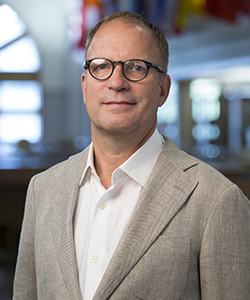Architects combine the raw materials of site, shelter, and human need to make significant places—places that are useful, durable, memorable, and inspiring. This equation is both incredibly complex and ancient. Today, however, the architect’s traditional tasks are supplemented by new ones: architects are leaders, collaborators, organizers, entrepreneurs, strategists, researchers, and inventors.
 The expanding demands placed on today’s architects require training beyond the limits of a strictly professional curriculum. Drury graduates are well prepared to meet these challenges with an education that is not only professionally rigorous and technically sound but also broadened and enriched by the foundation of a top-caliber liberal-arts curriculum. Our graduates think critically and creatively, communicate clearly and effectively, and empathize with their clients and the communities they represent.
The expanding demands placed on today’s architects require training beyond the limits of a strictly professional curriculum. Drury graduates are well prepared to meet these challenges with an education that is not only professionally rigorous and technically sound but also broadened and enriched by the foundation of a top-caliber liberal-arts curriculum. Our graduates think critically and creatively, communicate clearly and effectively, and empathize with their clients and the communities they represent.
The Drury Architecture program’s difference begins with its unique setting—a small liberal arts university committed to preparing students to think outside the limits of their particular discipline. Minors and double-majors are common and encouraged. Students have close one-on-one working relationships with faculty—facilitated by a student/faculty ratio below 14 to 1. For many graduates, these relationships lead to long-term and meaningful professional and personal mentorship.
In addition, the Drury Architecture curriculum extends beyond the design studio:
This sensitivity to the profession’s wider context is reflected in our student-body. While many students hail from the American Midwest, international students represent over 17% of our community. They are attracted by Drury Architecture’s rigorous professional program, but also by its difference—its emphasis on an education of both depth and breadth, its intense engagement with its local setting, and its commitment to the global dimensions of contemporary practice.
Robert Weddle
Professor and Dean, Hammons School of Architecture
International study is a hallmark of the Drury Architecture program and tradition. The HSA is one of few professional programs nationally in which all graduating students participate in an architecturally based study abroad experience. These experiences not only expose students to buildings and sites of great significance and beauty, they also give access to other cultures and traditions in ways that contribute to richer professional and personal lives for our graduates. Considering architectural, urban, and landscape issues in a broad cultural context is increasingly essential, as architectural practice becomes more global in scale.
Most HSA students participate in semester-long experiences at Drury’s campus in Aegina, Greece. The Drury Center in Greece architecture curriculum is fully integrated with the HSA recommended courses of study, so students can stay on track while also enjoying a semester of engagement with the beautiful island setting of Aegina. Other students complete alternative or shorter-term experiences in places like Paris, Amsterdam, Venice, Copenhagen, and Barcelona.
HSA study-abroad requirements and the Study Abroad Declaration Form can be found in the current edition of the HSA student handbook.
The Hammons School of Architecture is one of the only fully accredited architecture programs to exist within a small liberal-arts university. We emphasize one-to-one instruction from talented and connected professors, in classes and studios with low student-faculty ratios. Drury’s liberal-arts tradition and the personalized education it fosters give students broad preparation and superior critical-thinking and leadership skills.
To become a successful architect requires the cultivation of direct hands-on skills. Architects shape places and the lives of the people who use them, so they must be able to understand both how to put things together physically and how to communicate and relate to clients and building users. Our program complements theoretical understanding with direct practical experience in making and communicating.
While Drury’s liberal-arts environment creates a supportive setting for personalized architectural education, our students and our program are also connected to people and places around the globe—reflecting the increasingly global nature of architectural practice.
The Hammons School of Architecture prepares graduates for design excellence and professional leadership. These qualities are recognized by the many recognitions our students and graduates receive.
Among them:
The Hammons School of Architecture (HSA) offers a five-year first professional Master of Architecture degree that is fully accredited by the National Architectural Accrediting Board (NAAB), which requires that all accredited programs post the following statement:
In the United States, most registration boards require a degree from an accredited professional degree program as a prerequisite for licensure. The National Architectural Accrediting Board (NAAB), which is the sole agency authorized to accredit U.S. professional degree programs in architecture offered by institutions with U.S. regional accreditation, recognizes three types of degrees: the Bachelor of Architecture, the Master of Architecture, and the Doctor of Architecture. A program may be granted an eight-year, three-year, or two-year term of accreditation, depending on the extent of its conformance with established educational standards. Doctor of Architecture and Master of Architecture degree programs may require a preprofessional undergraduate degree in architecture for admission. However, the preprofessional degree is not, by itself, recognized as an accredited degree.
Drury University, Hammons School of Architecture, offers the following NAAB-accredited program:
M.Arch. (168 total credit hours; minimum 30 master’s-level credit hours)
The program received a full-term re-accreditation in 2016, and will next be re-accredited in 2024.
The NAAB requires that the following public information be made available by the program:
NAAB-mandated Interim Progress Reports and Annual Reports:
2016 Hammons School of Architecture NAAB Architecture Program Report
2016 NAAB Visiting Team Report
2016 NAAB Decision Letter
Admissions Information for prospective and current students
Advising Information for prospective and current students
Financial Information for prospective and current students
Financial Aid Information for prospective and current students
Career Development Information for prospective and current students